by Amineddoleh & Associates LLC | Nov 11, 2024 |
Developments in artificial intelligence (“AI”) are occurring at break-neck speed; just as this technology is rapidly evolving, the law is attempting to catch up. In the summer of 2023, our founder presented a lecture on the topic of AI and intellectual property law for Holo Art Collective. Since last year’s talk, “The Future of Copyright in AI Art,” there have been a flurry of AI developments and copyright law clarifications.
According to 15 U.S. Code § 9401, artificial intelligence is a “machine-based system that can, for a given set of human-defined objectives, make predictions, recommendations or decisions influencing real or virtual environments.” 15 U.S.C. § 9401. A type of AI, generative artificial intelligence (“GAI”), is defined as “an algorithm that generates new outputs based on the data it has been trained on. … Generative AI creates new content in the form of images, text, audio, and more.” AI Terms for Legal Professionals: Understanding What Powers Legal Tech, LexisNexis Legal Insights, March 23, 2023. GAI programs like DALL-E 2, Stable Diffusion, and Midjourney allow “artists and enthusiasts to produce innumerable works of great visual interest with simple textual instructions.”
 These tools have revolutionized the way artists create. Take musical genius Paul McCartney, who used artificial intelligence to help revive the cassette audio of the late John Lennon. McCartney and Ringo Starr used this breakthrough technology to help produce The Beatles’ final song Now and Then – the band’s first release since 1995. Remarkably, Now and Then just made history as the first AI-assisted song to earn a Grammy nomination.
These tools have revolutionized the way artists create. Take musical genius Paul McCartney, who used artificial intelligence to help revive the cassette audio of the late John Lennon. McCartney and Ringo Starr used this breakthrough technology to help produce The Beatles’ final song Now and Then – the band’s first release since 1995. Remarkably, Now and Then just made history as the first AI-assisted song to earn a Grammy nomination.
However, as AI enters a new era in the world of artistic creation, it’s worth remembering that the technology also has a dark side. Most notably, AI has spurred the creation of “deepfakes” or manipulated media that creates “realistic digital impersonations, avatars, or derivative images based on pre-existing source material.” For example, a creator called “Ghostwriter” wrote and released a song called “Heart on My Sleeve” using both Drake’s and the Weeknd’s voices. To the shock of the music industry, the song was submitted to the Grammy’s this year. Recording Academy CEO Harvey Mason Jr. told The New York Times, “It’s absolutely eligible because it was written by a human.”
This argument goes to the heart of burgeoning copyright law and the use of AI for creative works. In a blow to creators of AI-generated content, the U.S. Copyright Office reversed its decision last year to protect AI creator Kristina Kashtanova’s graphic novel, Zarya of the Dawn. The text of the book was written by Kashtanova, but the images were all generated by Midjourney, a generative AI program. Although the Copyright Office initially granted registration to Kashtanova, it withdrew it after learning that the images in her book were AI-generated. According to the Copyright Office, the basis for rejection was the lack of human authorship “[A]uthorship is protected by copyright. However…the images… are not the product of human authorship.” U.S. Copyright Office Review Board, Letter Response to Previous Response Seeking Additional Copyright Information for Zarya of the Dawn Registration # VAu001480196 (Previous Correspondence ID: 1-5GB561K).
Then in August of last year, a U.S. District Court upheld the Copyright Office’s denial of registration for another AI-generated work. In 2018, Stephen Thaler applied for a copyright for an artwork created by a computer system named “Creativity Machine.” The Copyright Office denied the application because the work “lack[ed] the human authorship necessary to support a copyright claim,” noting that copyright law only extends to works created by human beings, and the work in question was created solely by Creativity Machine. Thaler v. Perlmutter, 687 F. Supp. 3d 140, 143 (D.D.C. 2023). Thaler twice requested reconsideration, but they were denied both times. Finally, Thaler challenged this decision in the U.S. District Court of the District of Columbia.

“A Recent Entrance to Paradise,” created by the Creativity Machine
As the Court stated, Thaler “attempts to complicate the issues presented by devoting a substantial portion of his briefing to the… the work-for-hire doctrine.” Id. at 145. Importantly, the Court stated, “Copyright is designed to adapt with the times. Underlying that adaptability, however, has been a consistent understanding that human creativity is the sine qua non at the core of copyrightability.” Id. at 146. The DC Circuit emphasized that even as technology evolves and provides tools to artists, a human component is essential. The court noted, “[c]opyright has never stretched so far, however, as to protect works generated by new forms of technology operating absent any guiding human hand, as the plaintiff urges here. Human authorship is a bedrock requirement of copyright.” Id. at 146.
Judge Beryl A. Howell points back to the origins of copyright law in U.S. jurisprudence. She states that the requirement is part of the “plain text” of the Copyright Act. Id. at 146. The Act protects “original works of authorship fixed in any tangible medium of expression, now known or later developed, from which they can be perceived, reproduced, or otherwise communicated, either directly or with the aid of a machine or device.” 17 U.S.C. § 102(a). The court urges that “The ‘fixing’ of the work in the tangible medium must be done ‘by or under the authority of the author.’” Thaler, 687 F. Supp. 3d at 147 (quoting 17 U.S.C. § 101).
The court found that eligibility for copyright necessitates an actual “author,” and that the author must be a human being. Thaler, 687 F. Supp. 3d at 147. As such, the Copyright Office’s rejection stands. Thaler is currently appealing the decision.
Numerous other disputes have been settled during the past year, partly due to uncertainties in the law concerning AI-generated material. One matter, Main Sequence, Ltd. et al v. Dudesy, LLC et al, 2:24CV00711, was settled between the estate of comedian George Carlin and two podcasters who purportedly used AI to create a Carlin comedy special that was aired on YouTube. As part of the settlement, the podcasters removed the material from all platforms. They also reportedly agreed to permanently stop using Carlin’s image, voice, or likeness in any future podcast without consent.
The scope of AI’s effects can be seen across most industries. Dozens of other matters have been filed, with parties including news organizations, tech companies, politicians, fashion companies, record labels, artists, and authors. Therefore, it is not surprising that government agencies, including the US Executive Office, have addressed the role of AI in the realm of intellectual property.
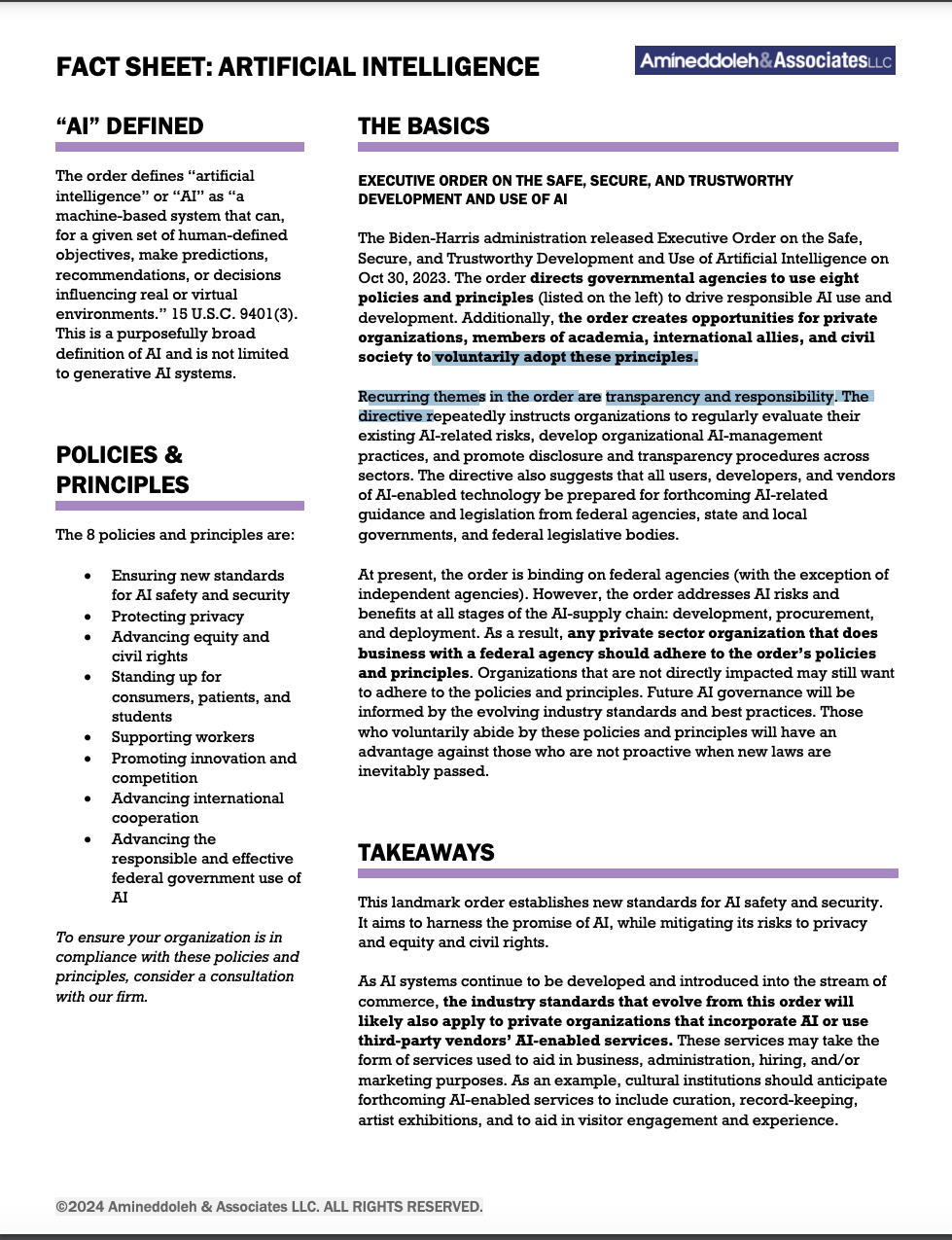 As previously discussed in our blog (which includes a helpful fact sheet) earlier this year, the US President addressed AI usage. In October 2023, the Biden-Harris administration released the Executive Order on the Safe, Secure, and Trustworthy Development and Use of Artificial Intelligence. The order broadly defines “AI” as “a machine-based system that can, for a given set of human-defined objectives, make predictions, recommendations, or decisions influencing real or virtual environments.” Exec. Order No. 14110, 88 Fed. Reg. 75191 (Oct. 30, 2023) (citing 15 U.S.C. 9401(3)). It also acknowledges that the Executive Offices “places the highest urgency on governing the development and use of AI safely and responsibly.” Exec. Order No. 14110, 88 Fed. Reg. 75191 (Oct. 30, 2023). As such, the order directs government agencies to abide by eight policies and principles to advance and govern the development and use of AI.
As previously discussed in our blog (which includes a helpful fact sheet) earlier this year, the US President addressed AI usage. In October 2023, the Biden-Harris administration released the Executive Order on the Safe, Secure, and Trustworthy Development and Use of Artificial Intelligence. The order broadly defines “AI” as “a machine-based system that can, for a given set of human-defined objectives, make predictions, recommendations, or decisions influencing real or virtual environments.” Exec. Order No. 14110, 88 Fed. Reg. 75191 (Oct. 30, 2023) (citing 15 U.S.C. 9401(3)). It also acknowledges that the Executive Offices “places the highest urgency on governing the development and use of AI safely and responsibly.” Exec. Order No. 14110, 88 Fed. Reg. 75191 (Oct. 30, 2023). As such, the order directs government agencies to abide by eight policies and principles to advance and govern the development and use of AI.
The U.S. Patent and Trademark Office (“USPTO”) has also addressed the use of AI. The USPTO states on its website that it is “focused on incentivizing more innovation, inclusively and in key technology areas such as artificial intelligence (AI) and other emerging technologies (ET) …protecting that innovation and bringing it to impact to enhance our country’s economic prosperity and national security and to solve world problems.” United States Patent and Trademark Office, Artificial Intelligence, https://www.uspto.gov/initiatives/artificial-intelligence.
Importantly, the US Copyright Office addresses AI-generated works in its bulletin, Copyright Registration Guidance: Works Containing Material Generated by Artificial Intelligence. 37 C.F.R. § 202 (2023). The bulletin provides instructions on how to properly apply for works containing AI-generated material.
Even the Federal Trade Commission launched an inquiry into generative AI investments. In January 2024, the FTC announced the issuance of orders to five companies (Alphabet, Inc.,Amazon.com, Inc., Anthropic PBC, Microsoft Corp., and OpenAI, Inc.) requiring them to submit information concerning investments and partnerships involving generative AI companies and major cloud service providers. While the agency recognizes that “new technologies can create new markets and healthy competition,” the FTC also has a role in guarding against tactics that would undermine fair competition.
These concerns are not unique to the U.S. The World Intellectual Property Organization (WIPO) has long considered the effects of AI on intellectual property and has questioned whether AI innovation needs the incentives generally associated with intellectual property, and if the advent of AI necessitates changes to long-standing IP principles and frameworks.
These are questions that creators, attorneys, and governments will be grappling with during the coming years and decades, as they balance the interests of AI, the law, and ethics.
by Amineddoleh & Associates LLC | Mar 5, 2024 |
In honor of International Women’s Day and Women’s History Month, our firm is reposting one of our favorite blog posts. This post originally ran on our firm’s blog in 2021.
—
It is a bitter truth that women, who are so often depicted, admired and romanticized through art, have had to overcome herculean obstacles to participate in its creation. In honor of Women’s History Month, this entry in our Provenance Series examines the work of the Old Masters’ female counterparts – the Old Mistresses – and their contemporary successors.
Rediscovery of Female Artists
Renaissance and Baroque works by women have deservedly entered the public consciousness in recent years. In 2019, a depiction of the Last Supper by nun Plautilla Nelli was installed in the Santa Maria Novella Museum in Florence, after a painstaking 4-year restoration by the Advancing Women Artists Foundation (AWA). The project was made possible through the AWA’s “adopt an apostle” crowdsourcing program: private financiers were allowed to “adopt” one of the life-sized disciples at $10,000 each (ever-unpopular Judas was instead funded by 10 backers at only $1,000 each). The oil painting, measuring 21 feet across, is one of the largest Renaissance works by a female artist still in existence. It is also the only work created by a woman during the Renaissance depicting the Last Supper.

Last Supper by Plautilla Nelli (prior to restoration). Image via My Modern Met.
The Provenance and Restoration of Plautilla Nelli’s The Last Supper
The Last Supper was likely created for the benefit of Plautilla’s own convent, the convent of Santa Caterina di Cafaggio in Florence, where it hung in the refectory (dining hall) until the Napoleonic suppression in the 19th century, when the convent was dissolved. It was thereafter acquired by the Florentine Monastery of Santa Maria Novella in 1817. Again, it was housed in the refectory until being moved to a new location in 1865. Scholar Giovanna Pierattini reports it was moved to storage in 1911, where it remained until 1939. It then underwent significant restoration, and returned to the refectory. It would remain on display there for almost forty years, surviving the historic flood of the Arno in 1966 with little damage. The work was next taken down in 1982, when the refectory was reclassified as the Santa Maria Novella Museum, and transferred to the friars’ private rooms. This is how the monumental work, which remained out of the public eye for centuries, is now visible to the public for the first time in 450 years.
Rossella Lari, the restoration’s head conservator remarks, “We restored the canvas and, while doing so, rediscovered Nelli’s story and her personality. She had powerful brushstrokes and loaded her brushes with paint.” The painting features emotionally charged expressions, emphatic body language, and exquisite details, such as the inclusion of customary Tuscan cuisine (roasted lamb and fava beans).
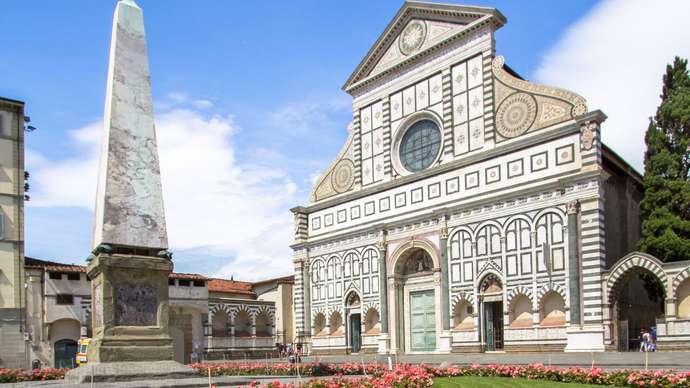
Santa Maria Novella in Florence, Italy. Image courtesy of CAHKT/iStock.com.
Plautilla’s use of color and composition is even more impressive when one considers that women were barred from attending art schools and studying the male nude; instead, they were forced to rely on printed manuals and the works of other artists. Plautilla was not only a self-taught artist, but she also ran an all-woman workshop in her convent and received the ultimate praise for an Italian Renaissance painter: inclusion in Giorgio Vasari’s seminal book Lives of the Most Excellent Painters, Sculptors and Architects. Notably, in Plautilla’s time the convent was managed by Dominican friars previously under the leadership of fire-and-brimstone preacher Girolamo Savonarola. The nuns were encouraged to paint devotional pictures in order to ward off sloth.
Undeterred, “Plautilla knew what she wanted and had control enough of her craft to achieve it,” says Lari. The Last Supper is signed “Sister Plautilla – Orate pro pictora” (“pray for the paintress”). Plautilla thus confirmed her role as an artist while acknowledging her gender, understanding that the two were not mutually exclusive. Although only a handful of the works survive today, Plautilla and her disciples created dozens of large-scale paintings, wood lunettes, book illustrations, and drawings with great focus, determination, and discipline. She is considered the first true woman artist in Florence and in her heyday, “There were so many of her paintings in the houses of gentlemen in Florence, it would be tedious to mention them all.” Since AWA’s conservation work was initiated, the number of works attributed to Plautilla has risen from three to twenty, meaning that other undiscovered masterpieces could be lying in wait.
Female-Led Museum Exhibitions
The Prado Museum in Madrid has hosted an exhibition featuring two overlooked Baroque painters, Sofonisba Anguissola and Lavinia Fontana, in an exhibition entitled “A Tale of Two Women Painters.” Meanwhile, the National Gallery in London hosted a show dedicated to Artemisia Gentileschi. Notably, Sofonisba, Lavinia and Artemisia all achieved fame and renown during their lifetimes, including royal commissions, only to be eclipsed for centuries after their deaths. Sofonisba was particularly sought after for her ability to capture the expressiveness of children and adolescents in intimate portraits, while Lavinia’s commissions displayed a more formal Mannerist style. Artemisia, the subject of the National Gallery’s first major solo show dedicated to the artist, is recognized as much for the strength of her figures in chiaroscuro as for her life story involving sexual assault and trial by torture. Despite considerable difficulties, Artemisia was able to succeed in a male-dominated field and created over 60 works, most of which feature women in positions of power. Artemisia is now hailed as one of the most important painters of her generation and an established Old Mistress in her own right.
Female Artists at Auction
Despite their long slumber in the annals of history, these artists are not only receiving attention in museums, but in auctions as well. In 2019, a painting by Artemisia depicting Roman noblewoman Lucretia shattered records when it sold for more than six times its estimated price at Artcurial in Paris. While estimates originally placed the work at $770,000 to $1 million, the painting was ultimately acquired by a private collector for $6.1 million. Lucretia was discovered in a private art collection in Lyon after remaining unrecognized for 40 years. It was in an “exceptional” state of conservation according to Eric Turquin, an art expert specializing in Old Master paintings previously at Sotheby’s.
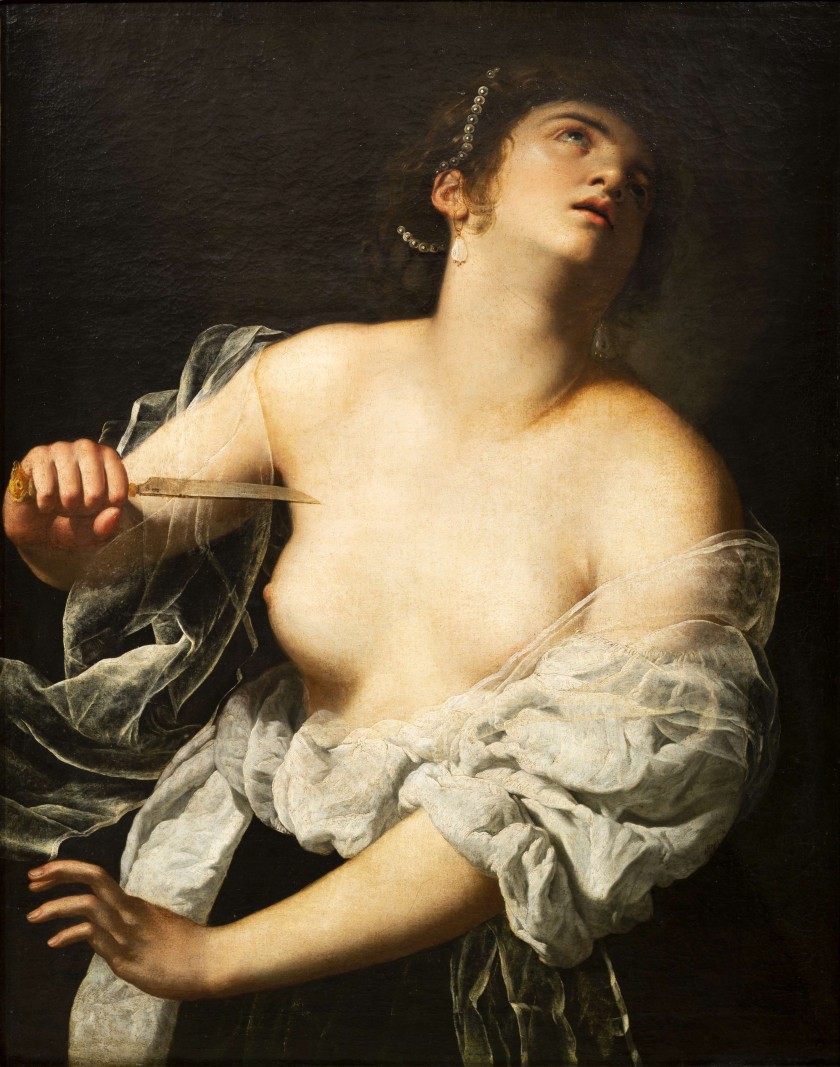
Artemisia Gentileschi’s Lucretia (ca. 1630-1640). Image via Getty Museum.
The earlier record for one of Artemisia’s works had been set in 2017, when a painting depicting Saint Catherine sold for $3.6 million. That painting, a self-portrait of the artist, was then acquired by the National Gallery in London for $4.7 million in 2018. This was the first painting by a female artist acquired by the National Gallery since 1991, and the 21st such item in its entire collection, which encompasses thousands of objects. Saint Catherine had been owned by a French family for decades, but its authorship was obscured prior to its rediscovery and sale by auctioneer Christophe Joron-Derem. The painting was acquired by the Boudeville family in the 1930s, but the exact circumstances of this acquisition and the painting’s prior whereabouts were unclear. At the time of the National Gallery’s purchase, museum trustees raised concerns that the work might have been looted during World War II, although there is no firm evidence to support this suspicion. Despite the gaps in the works’ provenance, it was ultimately determined that the painting had been with the family for several generations and Saint Catherine was welcomed to her new home in London.
Recent Attributions
More recently, a painting of David and Goliath was attributed to Artemisia after a conservation studio in London removed layers of dirt, varnish and overpainting to reveal her signature on David’s sword. While the work’s attribution occurred too late for inclusion in the National Gallery exhibition, the owner is apparently delighted to discover the work’s true author and is keen to loan it to an art institution so the public can enjoy the work. This painting was originally acquired at auction for $113,000 and may have been owned by King Charles I – quite an esteemed pedigree and sure to raise its value by a considerable amount.
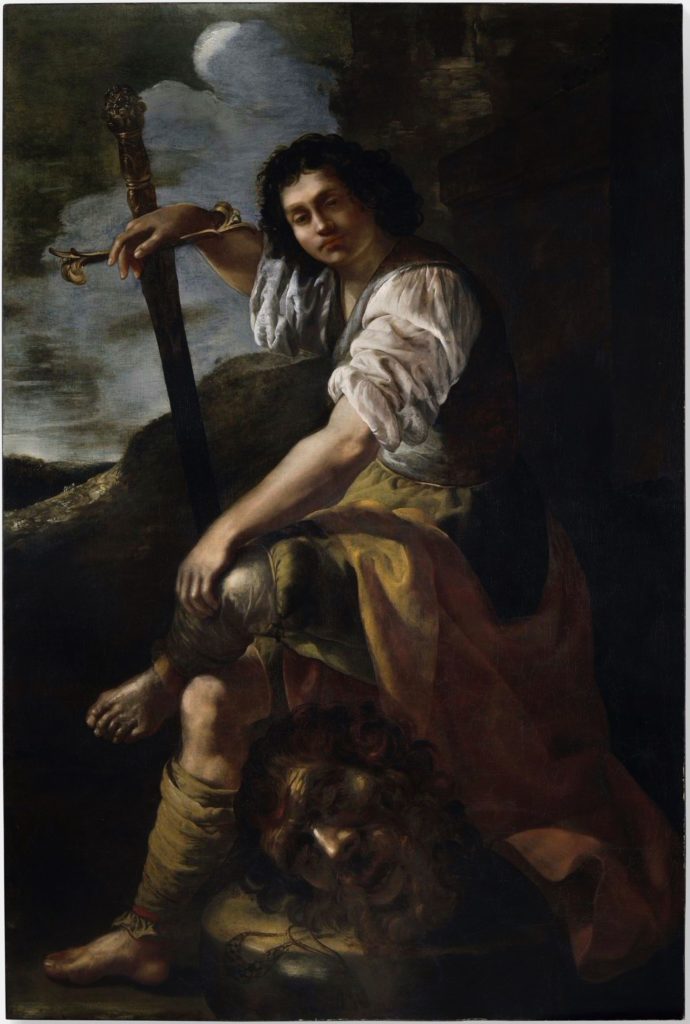
Artemisia Gentileschi, David and Goliath. Image courtesy of Simon Gillespie Studio.
In contrast to Artemisia’s ascendance, a painting once attributed to her father Orazio Gentileschi is now embroiled in controversy. That painting, which also depicts David and Goliath and described as “stunning” by the Artemisia show curator, has links to notorious French dealer Giuliano Ruffini. Ruffini is the subject of an arrest warrant due to his connection with a high-profile Old Master forgery ring operating in Europe. It is believed that the forgery ring, uncovered in 2016, garnered $255 million in sales, including works represented as being by Lucas Cranach the Elder and Parmigianino.
Although these paintings were widely accepted as genuine masterpieces and fooled leading specialists, they did not have verifiable provenances. The paintings were said to belong to private collector André Borie, although that was not the case and Sotheby’s was forced to refund money to buyers once the fraud came to light. The Gentileschi in question had been “discovered” in 2012 and sold to a private collector, who loaned it to the National Gallery in London. At that time, the painting was praised for its “remarkable” lapis lazuli background, but the museum did not conduct a technical analysis before displaying the piece. Despite several warning signs – the painting’s recent entrance into the art market, its unusual material, its similarity to another Gentileschi painting held in Berlin, and the lack of published provenance – the museum stated that there were “no obvious reasons to doubt” the painting’s attribution.
The forgotten nature of some female artists demonstrates that their talents are not rare, but rather that they lack the opportunities and publicity that male artists often take for granted. Once their talent is amplified, female artists are capable of great things. This pattern continues today.
The Modern Struggles of Female Artists
As famous female artists lost to history capture the public eye, they are joined by female contemporaries who share a similar struggle against underrepresentation. Women’s contribution to modern and contemporary art is often exemplifiedby those with ties to established male artists: Mary Cassatt (who achieved recognition as an Impressionist in Paris through her relationship with Edgar Degas); Georgia O’Keeffe (who entered the public eye via her relationship to Alfred Stieglitz); and Frida Kahlo (introduced to the art world by her husband, Diego Rivera). This truncated view ignores the vast amount of creative output generated by women, and reinforces the notion that recognition must be made through a male lens, a view prevalent during Artemisia’s time. It is worth noting that Artemisia’s father Orazio Gentileschi was her teacher and facilitator in the Baroque art market. In fact, this attitude has denied countless female artists of their deserving places in the canon of art history. It has even enabled surreptitious artists to take credit for works by others.
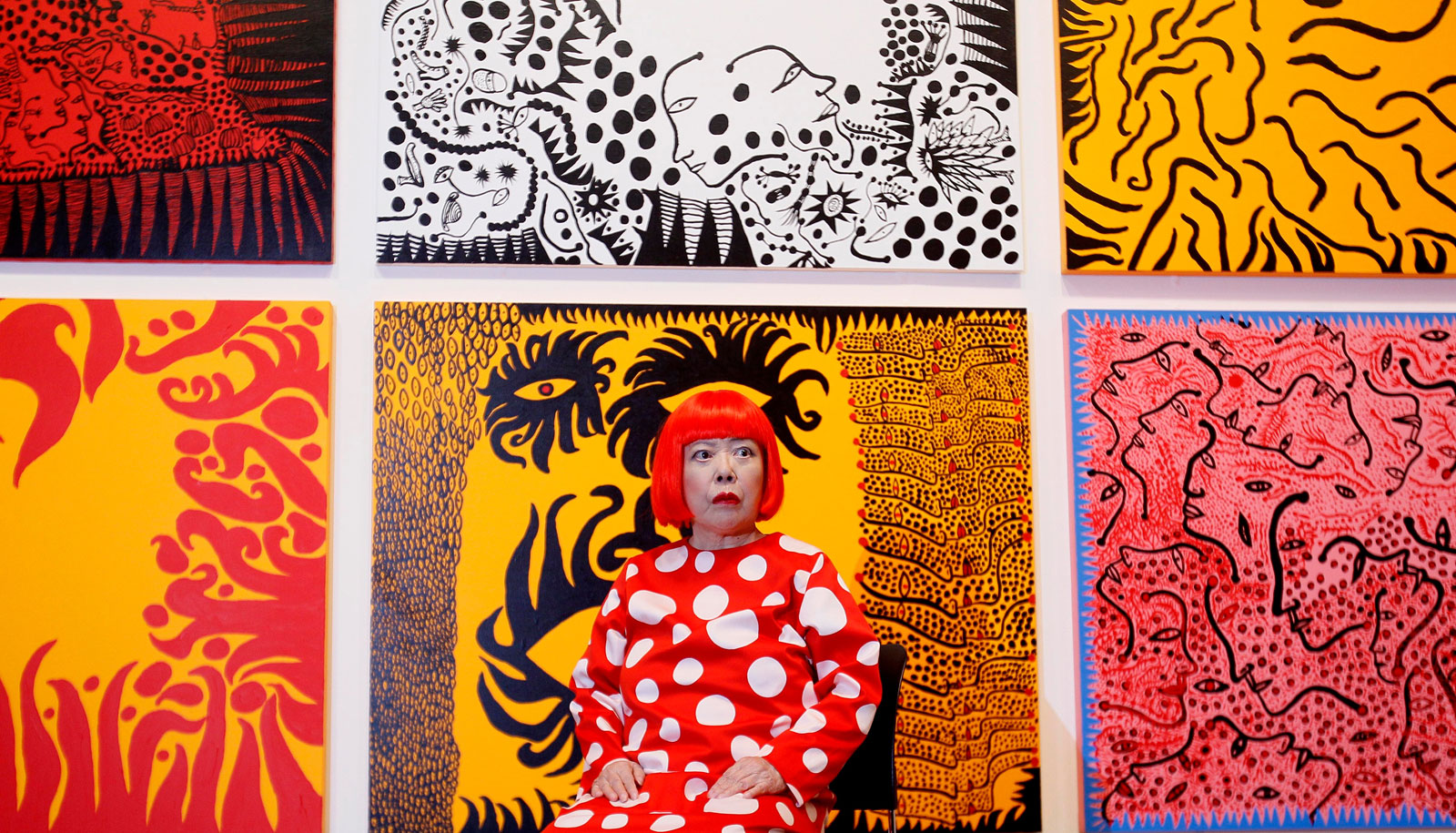
Yayoi Kusama.
Image courtesy of Kirsty Wigglesworth.
Today, Yayoi Kusama is a household name. The world’s top-selling female artist, she is renowned for her peculiar polka-dotted paintings and sculptures, which command long lines at preeminent art institutions across the globe. Like many famous contemporary artists from the last century, she is strongly associated with a unique personal style, and recognized by her bright-red wig. Despite her phenomenal success, her position in the pantheon of notable contemporary artists was anything but assured. Born in the rural town of Matsumoto, Japan in 1929, Kusama was discouraged from pursuing a career; rather, she was encouraged to marry and start a family. Frustrated by the constant efforts to suppress her artistic aspirations, she wrote to the already famous Frida Kahlo for advice. Kahlo warned that she would not find an easy career in the US, but nevertheless urged Kusama to make the trip and present her work to as many interested parties as possible.
Unsurprisingly, Kahlo’s advice was accurate. After traveling to New York, Kusama’s early work received praise from notable artists Donald Judd and Frank Stella, but it failed to achieve commercial success. Her work also attracted the attention of other renowned artists, who were able to channel ‘inspiration’ from Kusama’s work right back into the male-dominated New York art market. Sculptor Claes Oldenburg followed a fabric phallic couch created by Kusama with his own soft sculpture, receiving world acclaim. Andy Warhol repurposed her idea of repetitious use of the same image in a single exhibit for his Cow Wallpaper. Most blatantly, after exhibiting the world’s first mirrored room at the Castellane Gallery, Lucas Samaras exhibited his own mirrored exhibition at the Pace Gallery only months later. Needless to say, these artists did not credit Kusama for her work and originality. This ultimately caused a despondent Kusama to abandon New York and return to Japan.
Kusama spent the next several decades largely in obscurity. The frustrations in her career resulted in multiple suicide attempts and long-term hospitalizations. However, Kusama always found a way to channel this energy back into her art, and she continued to create art in various formats as a way to heal. It was not until a 1989 retrospective of her work in New York and an exhibition at the 1993 Venice Biennale that the world truly tok notice of her work. This global reintroduction was enough to galvanize interest in her artistic creation, leading to the success she enjoys today. While it may seem just that such a talented artist would eventually receive recognition for her work, this is not always a given and Kusama’s near erasure from the art world should not be discounted.
The Gendered Art Market Divide
In today’s art market, artists, collectors, dealers, and museums are making a concerted effort to fight this type of erasure. Kusama stands as a beacon to others, demonstrating that female artists can reach the pinnacle of their profession. However, it remains an arduous career path for many. Statistical analysis confirms that female artists are underpaid and underrepresented in both the primary and secondary art markets. For example, compare the highest price paid for a work by a living artist by gender: Jeff Koons’ Rabbit sold for $91.1 million in 2019; while Jenny Saville’s Propped sold for $12.5 million that same year, a mere 14% of the Koons’ price. Some of this disparity can be explained by the difference between men and women’s treatment in the workplace generally, but the art world is also subject to a number of particularities. Attributed to a host of causes, perhaps none is more prominent than women’s almost total exclusion from studio art until the 1870s. The art world has existed in this environment for so long that its institutions and relationships now mechanically reinforce the disparity between genders: women are less likely to receive recognition and training, and buyers are less interested in art created by females. The interest in female-made art is also disproportionality concentrated on its biggest names; the top five best-selling women in art held 40% of the market for works by women auctioned between 2008 and 2019. It has become a self-sustaining cycle that can only be broken through deliberate and effective action.
Initiatives Supporting Female Artists
Artists and galleries have been working to shine a light on the current landscape of inequality in the market. Groups like the Guerilla Girls have used their cultural status and notoriety to vocalize issues regarding sexism, racism, and other types of discrimination still rampant today. This type of radical-meets-reformer message resonates with a newer generation that is more vocal about addressing discrimination, and frustrated by the seemingly lackluster efforts to minimize their impact on society. In honor of Women’s History Month, several galleries have announced shows dedicated to addressing some of these issues. The Equity Gallery is presenting “FemiNest,” a collection of works by female artists centered around the literal and metaphorical ideas conjured by the idea of a “nest.” The show explores in sculpture, textiles, painting and other media the new spaces that have opened for women in recent decades and their practical and spiritual impact for women. The Brooklyn Museum has announced a retrospective of Marilyn Minter’s work titled “Pretty/Dirty” aimed at challenging traditional notions of feminine beauty. Featuring more than three decades of work, the show will track Minter’s progress throughout the 1970s, 80s, and 90s. The show is also part of a larger series of ten exhibitions by the Brooklyn Museum dedicated to the subject: “A Year of Yes: Reimagining Feminism at the Brooklyn Museum.” Lastly, the Zimmerli Art Museum will feature an exhibition of works by the Guerilla Girls and other female artists who have worked to depict women’s unequal treatment in the art world, “Guerrilla (And Other) Girls: Art/Activism/Attitude.” (For more information about these shows and others addressing similar issues, see here.)
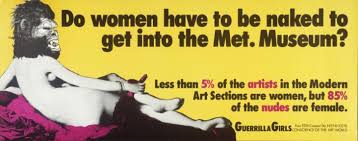
Do Women Have To Be Naked To Get Into the Met. Museum? (1989), Guerrilla Girls. Image via the Met.
Although artists and art institutions have just begun the work of winding back centuries of discrimination, there is evidence that their work is already affecting the market. The percentage of female-generated artwork in the secondary market is increasing from year to year; from 2008 to 2018, the market more than doubled from $230 million to $595 million. Similarly, representation of women at major art shows is steadily, if inconsistently, increasing as well. This subtle shift in the market has been attributed at least in part to a new class of art purchaser: independently wealthy women, whose capital is self-made rather than inherited or shared via marriage. This novel source of demand is less sensitive to the traditional pressures of the market and is helping to fuel demand for works by female artists. Women’s History Month is an opportunity to reflect on the tremendous progress made by remarkable individuals in the art world, and to also contemplate the ripe opportunities that still lie ahead.
by Amineddoleh & Associates LLC | Oct 26, 2023 |
Congratulations to our firm’s founder, Leila Amineddoleh, who successfully chaired the 15th Annual NYCLA Art Law Institute: New Insights in Art Law. This annual conference is one of the most highly-anticipated and innovative events of the year.

Peak fall foliage in NYC’s Central Park, just in time for the Conference. Image via Central Park Conservatory.
This year’s was no exception. The two-day event highlighted leading experts and voices in the our industry. Read below to get a glimpse of how panelists dove into the hottest topics facing artists and lawyers today – they dove into a wide array of topics, including evolving issues in the art market, art and cultural heritage law, and intellectual property.
New Developments, Dispute Resolution, & Art World Conflicts of Interest
Day 1 opened with a smash-hit panel. The panel, featuring Paul Cossu, Adrienne R. Fields, and Claudia Quinones, tackled new developments in art law and intellectual property. One highlight from this panel was the intersection of AI-created art and copyright law. A takeaway was that the U.S. Copyright Office tends to make decisions related to AI-created art based on whether AI was used merely as a tool, or whether AI was the true author.
Next, Gabrielle C. Wilson moderated a fascinating panel on resolving art disputes. The panel pondered the critical considerations and alternatives when resolving art disputes. This panel presented attendees with multiple, practical paths to use when dealing with these controversies. In some situations, art attorneys may find greater success by encouraging negotiation between parties, rather than pursuing litigation. As a whole, this second panel was a good reminder for art lawyers to continue to lean on their specific expertise in the art world to help both side achieve a just and equitable solution.
Finally, Katherine Wilson-Milne moderated a panel on art world conflicts of interest. The panel explored ways to approach these conflicts, including some suggestions for innovative paths forward. This panel encouraged participants to broaden their perception as to where art world conflicts may come from in subsequent years. With so many aspects of the cultural, financial, and political climate in flux, the art industry is being directly and indirectly impacted. It is essential for attorneys to be aware of new developments in art world conflicts of interest, and ways to best address them as they arise.
Title and Authenticity, Broken Promises, & Artist Residences
Day 2 narrowed the Conference’s focus even more precisely. The day started off with our firm’s own Yelena Ambartsumian’s presentation with Claudia Quinones. The two gave thoughtful insight and wisdom on issues surrounding title and authenticity. One highlight from Claudia’s portion included the latest developments in Nazi-looted artwork. She drew attention to the most essential cases to watch in the coming months, and provided great detail as to the specific laws at issue in each case.
Yelena then dove into powerful issues regarding cultural heritage. She brought specific attention to Armenian cultural heritage, and the current risk for destruction of such treasures. Yelena also explained the legal paths the Republic of Armenia has taken to protect their cultural heritage, due to a lack of UNESCO involvement. She also gave phenomenal insight into the hot top of authenticity issues. One takeaway from that aspect of her presentation is that, if there are reasons to be skeptical about the authenticity of a work of art, it is a good idea for the attorney to explore those suspicions!
Next up, our founder Leila moderated a fascinating panel on the enforceability of promised gifts and what happens when circumstances change. The length of time between the time the gift was made, and the time the gift is executed, was a major theme in this panel. The panel also parsed through the diverse scenarios that arise when receiving monetary gifts versus physical collections of art. In terms of physical artwork, the cost of conservation was also highlighted as an important factor in whether or not a museum or institution is even able to properly receive a certain gift. This point is especially poignant in the industry’s current climate, as costs of conservation continue to rise alongside other financial needs of leading institutions.
Melissa Passman wrapped up the day by moderating the final panel of the Conference. This closing panel explored artist residence issues, and how to navigate founder and participant relationships. One takeaway was that the resources made available to artists in these relationships tend to drive the residency as a whole. As a result, it’s important for attorneys involved to be aware of the specialized spaces and studios that may be necessary. Otherwise, it would be impossible for the artists to work and fulfill the terms of their residencies. Another takeaway was that tax laws tend to dictate what non-profit organizations are able to accomplish in these relationships. Because this could complicate artist payment in residencies, it is necessary for lawyers working with these clients to be well-aware of tax obligations, and to make that a driving factor in negotiating agreements.
Another great year!
In all, attendees experienced two action-packed days of practical advice and innovative guidance. Our firm commends all of the presenters for their hard work and fascinating presentations. We look forward to this conference each year, and this year’s was truly a celebration of the best, boldest, and brightest minds in our ever-evolving field.
Let the record stand that peak fall foliage in Central Park has its perks, but the real highlight of October in NYC is the Annual Art Law Institute.
P.S. Missed the Conference? Get in touch with NYCLA here to purchase the recording when it is released.
 These tools have revolutionized the way artists create. Take musical genius Paul McCartney, who used artificial intelligence to help revive the cassette audio of the late John Lennon. McCartney and Ringo Starr used this breakthrough technology to help produce The Beatles’ final song Now and Then – the band’s first release since 1995. Remarkably, Now and Then just made history as the first AI-assisted song to earn a Grammy nomination.
These tools have revolutionized the way artists create. Take musical genius Paul McCartney, who used artificial intelligence to help revive the cassette audio of the late John Lennon. McCartney and Ringo Starr used this breakthrough technology to help produce The Beatles’ final song Now and Then – the band’s first release since 1995. Remarkably, Now and Then just made history as the first AI-assisted song to earn a Grammy nomination.
 As previously discussed in our blog (which includes a helpful fact sheet) earlier this year, the US President addressed AI usage. In October 2023, the Biden-Harris administration released the Executive Order on the Safe, Secure, and Trustworthy Development and Use of Artificial Intelligence. The order broadly defines “AI” as “a machine-based system that can, for a given set of human-defined objectives, make predictions, recommendations, or decisions influencing real or virtual environments.” Exec. Order No. 14110, 88 Fed. Reg. 75191 (Oct. 30, 2023) (citing 15 U.S.C. 9401(3)). It also acknowledges that the Executive Offices “places the highest urgency on governing the development and use of AI safely and responsibly.” Exec. Order No. 14110, 88 Fed. Reg. 75191 (Oct. 30, 2023). As such, the order directs government agencies to abide by eight policies and principles to advance and govern the development and use of AI.
As previously discussed in our blog (which includes a helpful fact sheet) earlier this year, the US President addressed AI usage. In October 2023, the Biden-Harris administration released the Executive Order on the Safe, Secure, and Trustworthy Development and Use of Artificial Intelligence. The order broadly defines “AI” as “a machine-based system that can, for a given set of human-defined objectives, make predictions, recommendations, or decisions influencing real or virtual environments.” Exec. Order No. 14110, 88 Fed. Reg. 75191 (Oct. 30, 2023) (citing 15 U.S.C. 9401(3)). It also acknowledges that the Executive Offices “places the highest urgency on governing the development and use of AI safely and responsibly.” Exec. Order No. 14110, 88 Fed. Reg. 75191 (Oct. 30, 2023). As such, the order directs government agencies to abide by eight policies and principles to advance and govern the development and use of AI. 






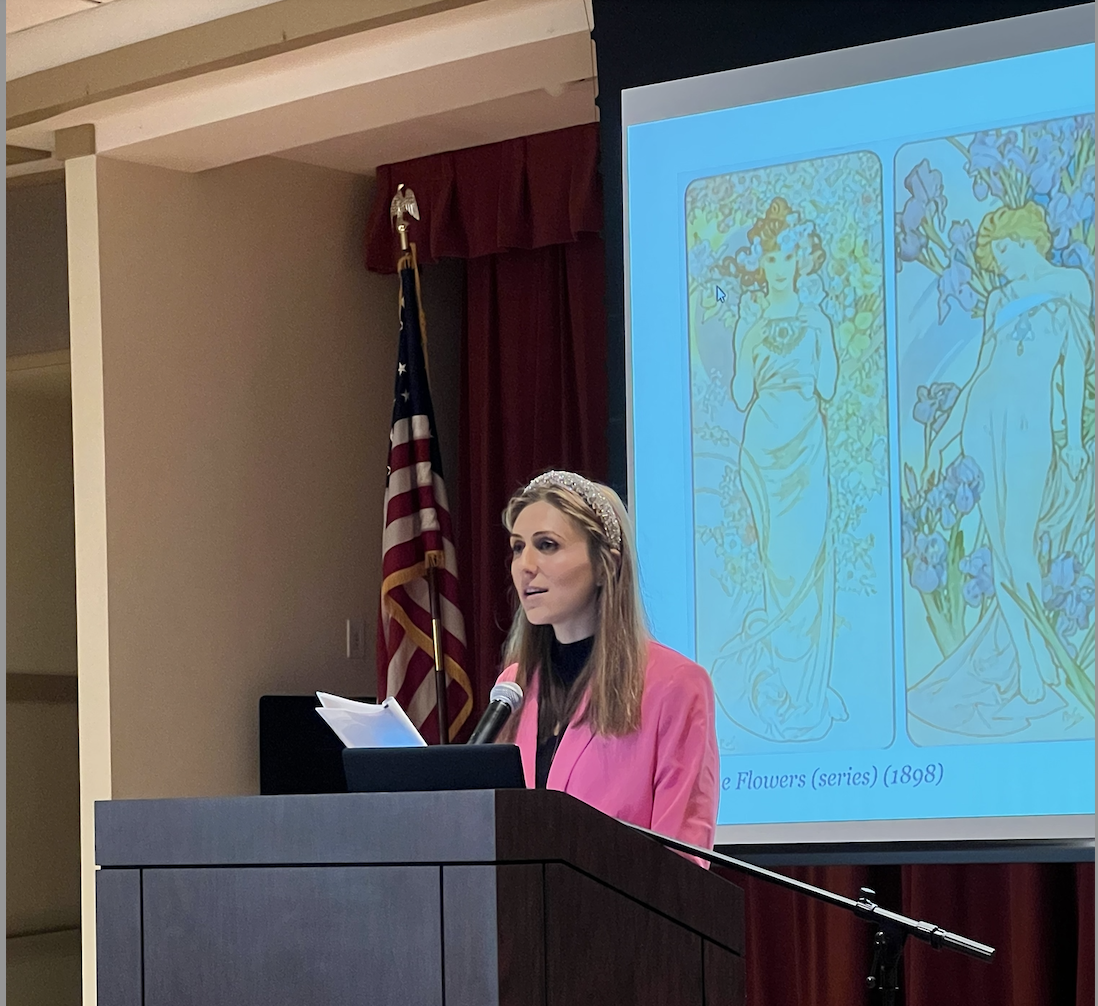
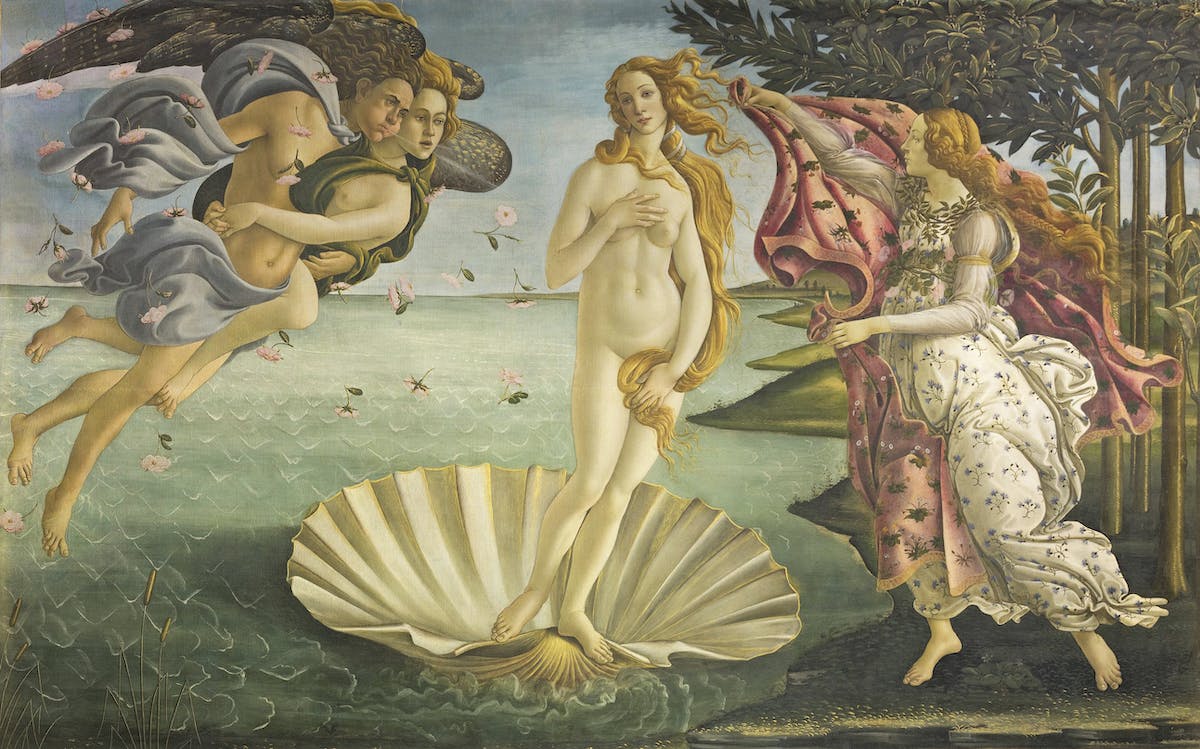 Last month Leila was quoted by The Art Newspaper and the Observer. With the Art Newspaper she discussed
Last month Leila was quoted by The Art Newspaper and the Observer. With the Art Newspaper she discussed